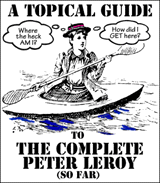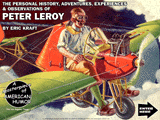
by Mark Dorset
A fictional town on the south shore of Long Island, New York, U.S.A.
“The scene [of ridiculous comedy, comedy that ridicules, as differentiated from ludicrous comedy] might normally be neutralized by being set in some distant country or operatic never-never-land. ‘As for the action . . . ,’ Alfred Jarry announced at the beginning of Ubu Roi, ‘the place is Poland, that is to say Nowhere.’ ”
Harry LevinThe villages slept as the capable man went down,
Playboys and Killjoys: An Essay on the Theory and Practice of Comedy
Time swished on the village clocks and dreams were alive,
The enormous gongs gave edges to their sounds,
As the rider, no chevalere and poorly dressed,
Impatient of the bells and midnight forms,
Rode over the picket rocks, rode down the road,
And, capable, created in his mind,
Eventual victor, out of the martyrs' bones,
The ultimate elegance: the imagined land.
Wallace Stevens“Of Framley Parsonage I need only further say, that as I wrote it I became more closely acquainted than ever with the new shire which I had added to the English counties. I had it all in my mind,—its roads and railroads, its towns and parishes, its members of Parliament, and the different hunts which rode over it. I knew all the great lords and their castles, the squires and their parks, the rectors and their churches. This was the fourth novel of which I had placed the scene in Barsetshire, and as I wrote it I made a map of the dear county. Throughout these stories there has been no name given to a fictitious site which does not represent to me a spot of which I know all the accessories, as though I had lived and wandered there.”
“Mrs. Alfred Uruguay”
Anthony Trollope, An Autobiography“I remember [Meyer] Schapiro telling us that before Cézanne,
there had always been a place in landscape painting where the viewer could walk into the picture. There was an entrance; you could go there, like walking into a park. But this was not true of Cézanne’s landscapes, which were cut off absolutely, abstracted from their context. You could not walk into them—you could enter them only through art, by leaping.”
Anatole Broyard, Kafka Was the Rage

